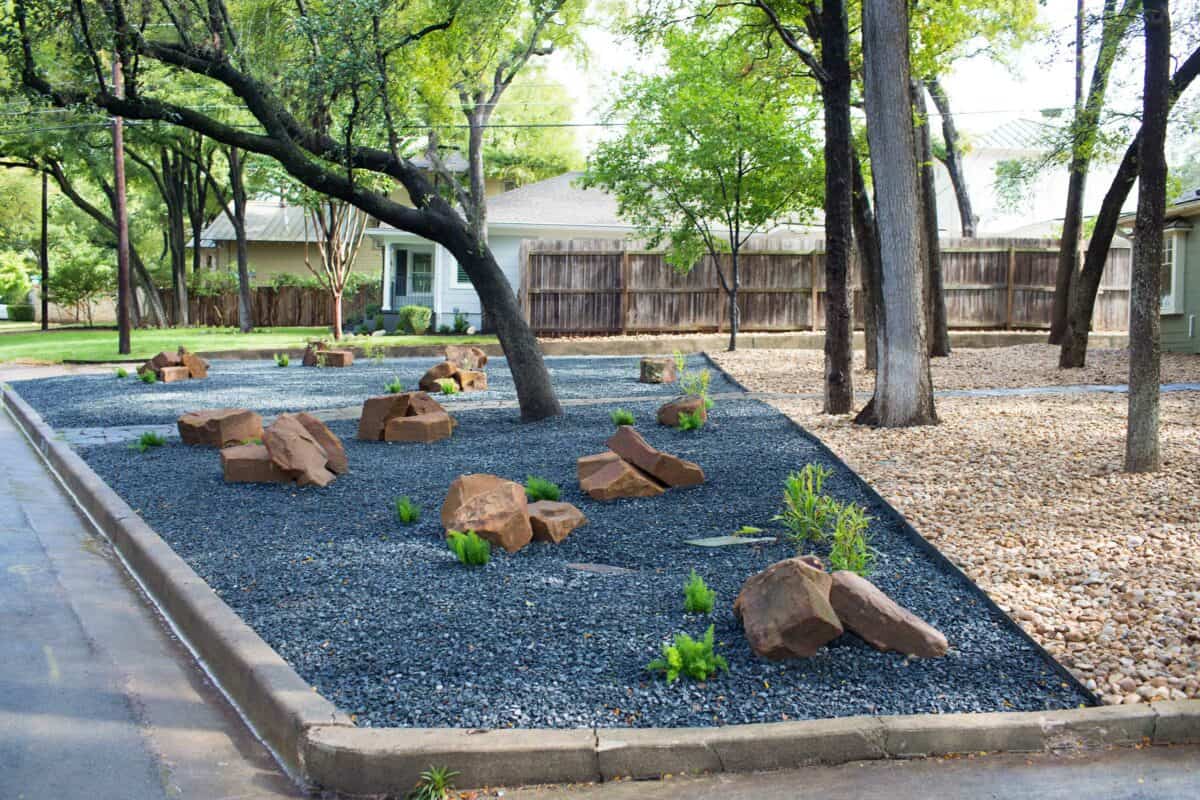Hello, and welcome to our second design that we are going to present and discuss about. Hopefully we could explain and elaborate clearly enough about some sound Xeriscaping practices.
The owner lost a good portion of lawn in last year’s drought and decided that instead of replacing this water-hungry-maintenance-fest feature he would rather convert the dead space into lovely drought tolerant landscaping done with Texas native plants. The property is mostly full sun with an existing medium tree on the left side. The client fonds agaves, ornamental grasses and enjoys the aesthetics of lime boulders. We drafted a few designs and provided him with a free bid.
The boulders that will be used are lime rocks which are native to the Austin and Central Texas area. Ornamental Rocks and boulders can really make your whole landscape pop out and add something really majestic to the whole composition. A few boulders, hand picked for size and shape and strategically scattered in the landscape contribute to a classic natural and “desert” look that some folks swear by. In this scale, two to four tons would be sufficient.
The agave chosen is our tried and true, trusted Agave Americana. Hey, if it aint broken, right? This Century Plant agave is quite common in Austin and Central Texas Xeriscape flowerbeds. It is reliable and has a classic agave shape and look. Its majestic and rare bloom will flock the whole neighborhood to your yard as it is a true sight to behold. No doubt, this plant is the focal point in the whole design. Native to Texas and Mexico, Agave Americanas have truly epic low water requirements; thriving on a pity water allowance as low as 8 inches of rain a year! We decided to place this Century plant far back in the bed as when it gets big its thorns are quite pedestrian unfriendly (unless you enjoy decorating your agave spikes with Christmas ornaments, mid march). A nice little trivia is that the plant is called Century Plant because due its very long bloom period people assumed it blooms once a century. In actuality, It will bloom in ten to twenty years. The plant sacrifices all its energy and vigor for this one dramatic show, and then withers away. No worry though, many small agave pups will soon take over and continue its fine heritage. A large plant and a smaller one placed close to each other for interesting asymmetry.
Grasses tend to work particularly well when scattered about with agaves in the background. We chose two different kinds: Gulf Muhly, and Mexican Feathergrass. They look similar yet different in some properties; Mexican Feathergrass tends to be a foot shorter than the Gulf Muhly which is also a bit wider. They are both quite drought tolerant, but the Feathergrass thrives on even less water. I really like Gulf Muhly due to its spectacular purple haze colored wispy foliage during the fall. Grasses work really well when you use them in clusters and communities scattering them as the wind would scatter seeds naturally.
Next is Silver Ponyfoot which is, in my opinion, hands down the best drought tolerant ground cover you can wish for in Central Texas and Austin. It is also, like the grasses, works best when planted a mass. Dichondra is native to West and Central Texas, and will survive with as little as 15 inches of annual rain. It is commonly used in hanging baskets and containers, or drooping gracefully above retaining walls. We love designing with Silver Ponyfoot as an interesting foreground accent.
Blackeyed Susan are planted amass in both the beds. Its big dark yellow daisy flowers are sure to cheer any admirer. The plant is quite drought tolerant, but will grant you far more blooms and color with additional water. Extra long blooming period (Mid may until October) is always a major plus. Although Blackeyed Susan is considered a short lived perennial it readily self reseeds.
Pride of Barbados? They should start calling this big boy “Pride of CenTexos” (I know, the puns are golden…). This is one of our favorite choices when we want to fill a large space in full sun on a budget. A nice and healthy established Pride of Barbados can be a 6 by 6 beauty so be sure to design it with ample space in mind. It’s a bit frost tender and will die to the ground on some winters. On extra harsh winters, without any protection, Pride of Barbados can completely and permanently die. In spite this one shortcoming we feel the plant offers too much to skip it.
The two remaining elements are Fall Aster and Texas Lantana. We talked about those plants in the previous design post, so I won’t elaborate too much. Texas Lantana color works well with Blackeyed Susan. Fall Aster purple will blend well with Gulf Muhly’s purple foliage during fall.
As you can see the right bed is more color focused and crowded, the right bed is more open and desert looking.
That’s it for now folks and fellow Central Texans! I hope you all enjoyed reading my plant babble and some of my thoughts regarding different considerations when designing drought tolerant flowerbeds here in Austin and Central Texas.
We offer superb Xeriscape flowerbeds designs and installation. Our prices are fair and the turnover is fast! Try us today.
We are going to try and post a new design every two weeks, so be sure to subscribe or just visit often.
Next design is a HUGE, intricate, 4200 square feet of native plants lanscaping with over 25 different plant varieties! Can’t wait? I know I can! (To write about it, that is…)
If you have any questions, clarification requests or just plain comments, please respond in the form below. I enjoy knowing I am not writing this to the ether 🙂








